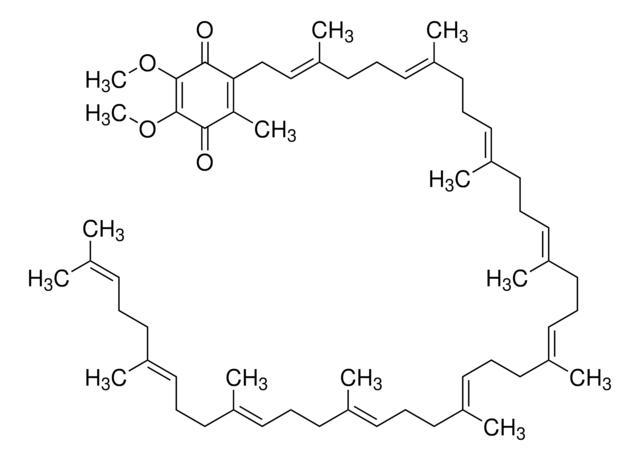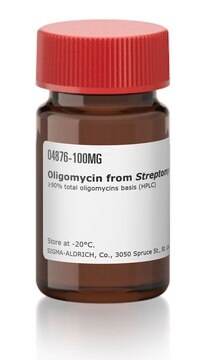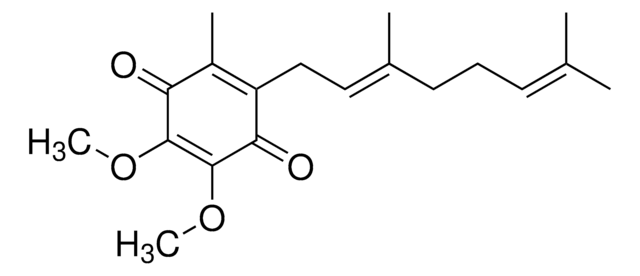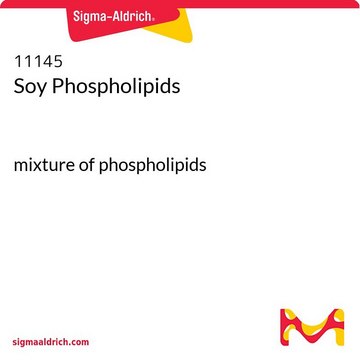Kluczowe dokumenty
D7911
Decylubiquinone
≥97% (HPLC)
Synonim(y):
2,3-Dimethoxy-5-methyl-6-decyl-1,4-benzoquinone
About This Item
Polecane produkty
Poziom jakości
Próba
≥97% (HPLC)
Postać
liquid
temp. przechowywania
−20°C
ciąg SMILES
CCCCCCCCCCC1=C(C)C(=O)C(OC)=C(OC)C1=O
InChI
1S/C19H30O4/c1-5-6-7-8-9-10-11-12-13-15-14(2)16(20)18(22-3)19(23-4)17(15)21/h5-13H2,1-4H3
Klucz InChI
VMEGFMNVSYVVOM-UHFFFAOYSA-N
Opis ogólny
Zastosowanie
- Lysosomal Ca(2+) as a mediator of palmitate-induced lipotoxicity.: This study explores the role of decylubiquinone in modulating lysosomal Ca(2+) levels, providing insights into mechanisms of lipotoxicity and potential therapeutic applications in metabolic diseases (Oh et al., 2023).
- Quinone binding site in a type VI sulfide:quinone oxidoreductase.: This paper investigates the binding dynamics of decylubiquinone in sulfide:quinone oxidoreductase, shedding light on its role in microbial respiration and potential biotechnological applications (Miklovics et al., 2022).
- Protective role of Decylubiquinone against secondary melanoma at lung in B16F10 induced mice.: The study demonstrates the anti-metastatic properties of decylubiquinone in a melanoma mouse model, highlighting its potential as a therapeutic agent in cancer treatment (Chatterjee et al., 2023).
- Decylubiquinone Inhibits Colorectal Cancer Growth Through Upregulating Sirtuin2.: This research identifies decylubiquinone as an inhibitor of colorectal cancer growth by modulating Sirtuin2 expression, suggesting its application in cancer therapeutics (Li et al., 2021).
Kod klasy składowania
10 - Combustible liquids
Klasa zagrożenia wodnego (WGK)
WGK 3
Temperatura zapłonu (°F)
Not applicable
Temperatura zapłonu (°C)
Not applicable
Środki ochrony indywidualnej
Eyeshields, Gloves, type ABEK (EN14387) respirator filter
Certyfikaty analizy (CoA)
Poszukaj Certyfikaty analizy (CoA), wpisując numer partii/serii produktów. Numery serii i partii można znaleźć na etykiecie produktu po słowach „seria” lub „partia”.
Masz już ten produkt?
Dokumenty związane z niedawno zakupionymi produktami zostały zamieszczone w Bibliotece dokumentów.
Klienci oglądali również te produkty
Nasz zespół naukowców ma doświadczenie we wszystkich obszarach badań, w tym w naukach przyrodniczych, materiałoznawstwie, syntezie chemicznej, chromatografii, analityce i wielu innych dziedzinach.
Skontaktuj się z zespołem ds. pomocy technicznej










